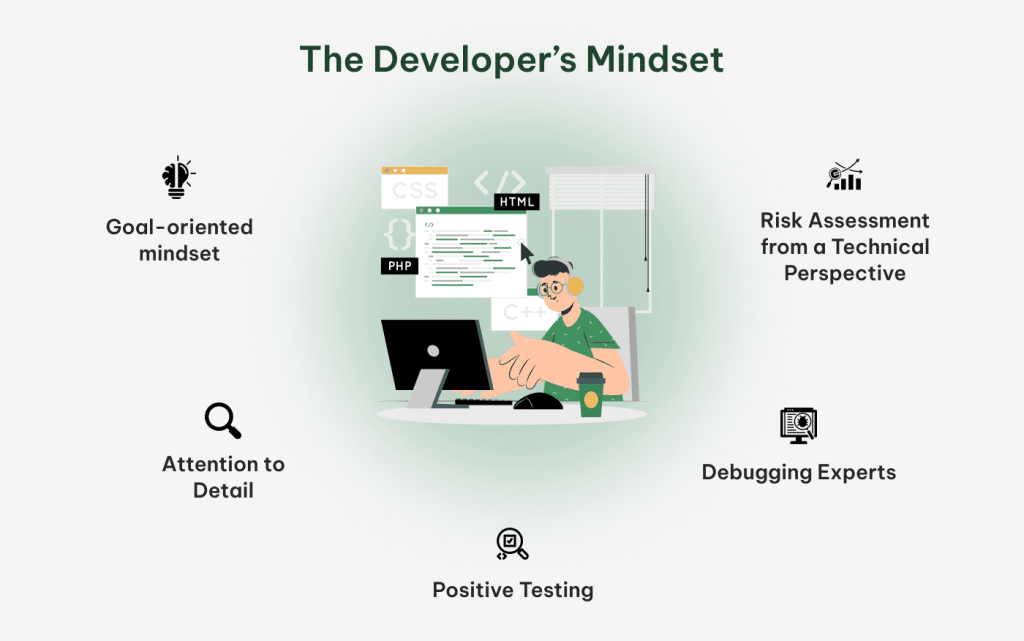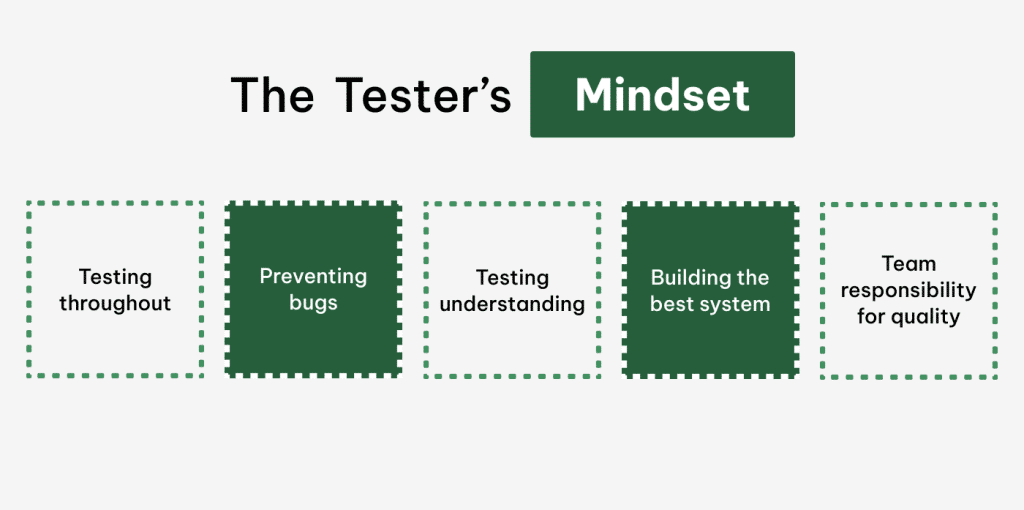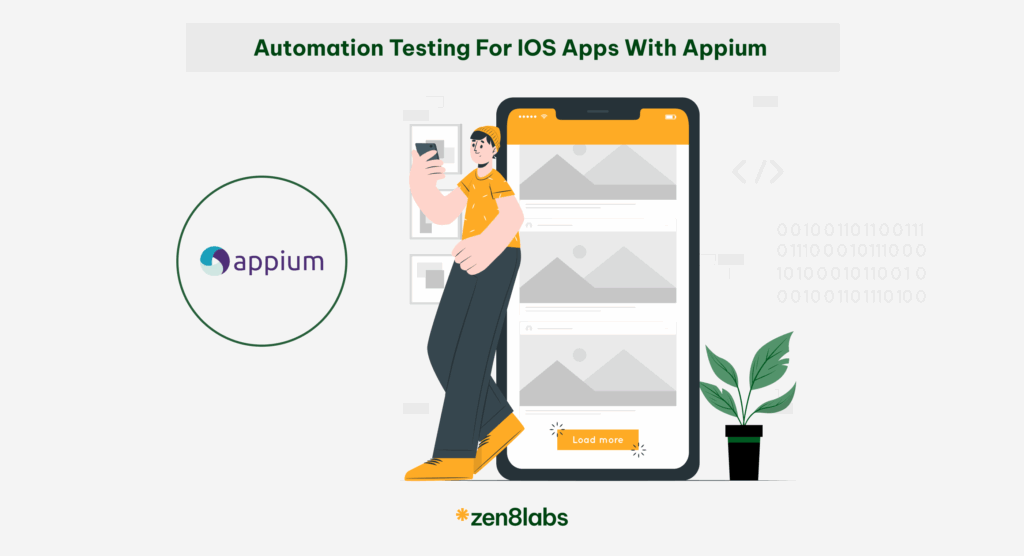Quality software doesn’t happen by chance; it’s the result of a dynamic partnership between testers and developers. As Steve Jobs once said, ‘Great things in business are never done by one person; they’re done by a team of people.’
At zen8labs, we believe in the transformative power of collaboration between testers and developers, each contributing their unique mindset to craft exceptional software. Thus, in the always changing field of software development, understanding and nurturing the mindsets of testers and developers can be the key points. In this blog post, we’ll explore how these two roles, often seen as distinct, can join forces in a harmonious collaboration that elevates the standards of software excellence.

The Developer’s Mindset
It’s common knowledge that developers are the soul of an IT company, and at zen8labs, this is especially true because they are essential to the creation of the software that serves as the foundation of our services. Additionally, their mindset is fundamentally goal-oriented, centered on creating and implementing software features with precision and ingenuity. To shed light on the developer’s unique perspective, let’s go into specific explanations and concrete examples.

Goal-oriented mindset
Developers are not just coders; they are creative problem solvers. They have a goal-oriented mindset, focused on bringing ideas to life through code. Their primary mission is to create and implement software features, ensuring that they function as intended. Developers often find creative solutions to complex technical challenges, crafting the foundation upon which a software application is built.
Attention to Detail
While developers certainly need to pay attention to detail, their main focus is on coding and programming. They are meticulous in writing efficient and clean code, but their priority lies in delivering new features and improvements to the software. This can sometimes lead to overlooking edge cases that testers are experts at uncovering.
Imagine a team of developers working on a web-based project management tool for businesses. The objective is to develop a user-friendly platform that makes reporting, task management, and collaboration easier. In this context, attention to detail becomes a critical element of the development process.
Risk Assessment from a Technical Perspective
Developers assess risk in terms of technical feasibility, scalability, and performance. They aim to minimize technical debt and ensure that the software operates smoothly. Their primary concern is often meeting deadlines and delivering a working product on time.
Suppose they are working on an e-commerce website. They consider the possibility of a sudden influx of visitors during a holiday sale event. Their perspective prompts them to assess potential bottlenecks in the system, such as slow database queries or insufficient server resources. To mitigate these risks, they implement techniques like query optimization and server scaling to ensure the site remains responsive and available.
Positive Testing
Positive testing is an integral part of the developer’s role. They design and conduct tests to validate that their code performs correctly under expected conditions. For instance, if they’re working on a video streaming application, positive testing involves ensuring that videos load and play smoothly, audio syncs properly, and users can navigate content without glitches. Developers aim to deliver features and functionalities that meet user expectations.
Debugging Experts
When defects or issues arise, developers are the first responders they quickly identify the root cause of the issues. They are responsible for debugging and fixing problems within their own code such as a misconfigured database query or a synchronization problem with external systems. They then proceed to rectify the problem by refining the code, ensuring the app’s continued reliability and security. This requires a deep understanding of the software’s inner workings and an ability to troubleshoot and resolve issues efficiently.
To sum up, the innovative spirit and desire to produce software that fulfills particular requirements are what propel developers. The combination of their technical expertise and problem-solving abilities allows them to turn ideas into useful apps. As architects of software systems, developers build the groundwork and achieve the ambitious ideas behind projects.
The Tester’s Mindset
At zen8labs, we recognize the critical role that testers play in the complex fields of software development. A unique mindset that drives them to strive for functionality and quality which is an asset to the work of developers. Let’s explore the many facets of the tester’s mindset and how it works with the development process, with examples to support our points.

Dedicated Problem Solvers
Testers, on the other hand, have a different mission. Their mindset is rooted in finding flaws and vulnerabilities in the software. They approach the software with a critical eye, challenging it in various ways to uncover its weaknesses. Testers are dedicated problem solvers who think about how to make the software fail.
Critical Thinking
Testers approach the software with a critical eye, dissecting it to identify flaws and inconsistencies. They think like end-users but also act as detectives, scrutinizing every aspect of the application.
For example, when testing an e-commerce website, a tester may notice a critical bug where certain transactions aren’t being recorded, potentially leading to financial discrepancies and user dissatisfaction. Another example is a tester finding a security vulnerability in financial software that could expose sensitive customer data.
Curiosity
Testers should be inherently curious, always seeking to explore the software from different angles and under various conditions. Their curiosity leads to the discovery of hidden defects and potential improvements in the applications. By approaching the software with an inquisitive mindset, testers help ensure that software functions seamlessly under a range of scenarios.
Imagine a tester evaluating a mobile app and deciding to test it under various network conditions. This proactive approach reveals that specific features fail to function in low-network areas, improving the app’s reliability and ensuring users have a seamless experience.
In another scenario, testers might delve into a healthcare application to discover that certain data inputs result in inaccurate calculations, potentially jeopardizing patient safety.
Advocacy for Users
They prioritize the user experience, ensuring software not only performs correctly but also delights users. This advocacy results in user-friendly interfaces and applications that provide a positive experience for customers and clients.
As advocates, they might insist on revising a healthcare application’s convoluted user interface to improve its usability, enhancing the overall experience for patients and medical staff. Similarly, a tester might discover that in educational software, a user journey is interrupted by confusing instructions, leading to students’ frustration and decreased engagement.
Effective Communication
Clear and constructive communication is a hallmark of testers. They excel in conveying their findings to the development team, providing comprehensive bug reports and feedback. Their ability to articulate issues and solutions with precision ensures that zen8labs developers can efficiently address and resolve identified problems.
In summary, the tester’s mindset is characterized by critical thinking, curiosity, user advocacy, effective communication, and unwavering resilience. This mindset plays a vital role in achieving software excellence, ensuring that zen8labs products are of the highest quality and meet the needs and expectations of end-users.
Fostering Collaboration for Quality Software
The cultivation of collaboration between testers and developers is essential for ensuring top-tier software quality. Software that not only meets but frequently exceeds expectations is largely dependent on the dynamic partnership between these important roles in the software development process. The success of this cooperative endeavor depends on the values of clear communication, shared goals, and interactive improvement to the ultimate objective of delivering reliable, user-centric software.

Open Communication
Open and transparent communication is the cornerstone of our collaborative efforts. This communication is not merely a transaction of information but a dynamic process which includes thorough bug reporting with reproducible steps, a continuous feedback loop, collaborative problem-solving, clarifying expectations, and sharing documentation. This dynamic exchange of information and insights fosters mutual understanding, enabling both parties to work as a team. It is through open communication that software imperfections are efficiently addressed, and software development aligns with user needs and technical possibilities.
Shared Goals
The alignment of common objectives is a fundamental component of our cooperative mentality. At zen8labs, we place a strong emphasis on the fact that every team member, regardless of position, is committed to delivering software that not only works but also excels in quality. By recognizing this shared objective, collaboration becomes a partnership rather than a transactional relationship. We collectively work towards the common goal of producing software that meets or surpasses user expectations.
Iterative Improvement
Collaboration isn’t just about initial teamwork; it’s also about iterative improvement. We have a culture of welcoming feedback and critique as a catalyst for growth. Our teams embrace a mindset of continuous refinement, using feedback from all team members to enhance our processes, code quality, and overall performance. This iterative improvement cycle ensures that we evolve as a team, adapting to changing requirements and industry standards, ultimately delivering software that becomes progressively better with each iteration.
In conclusion, the collaboration between the tester’s and developer’s mindsets is the key to delivering quality software. When these two mindsets come together, the result is software that is not only feature-rich but also robust, reliable, and capable of meeting user expectations. Understanding and appreciating the differences in mindset between testers and developers is crucial for successful software development projects.
Read our blog for more useful insights about software quality assurance.
Quynh Le – Quality Assurance






